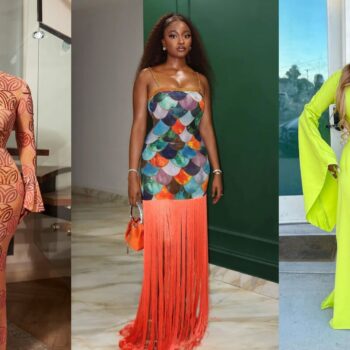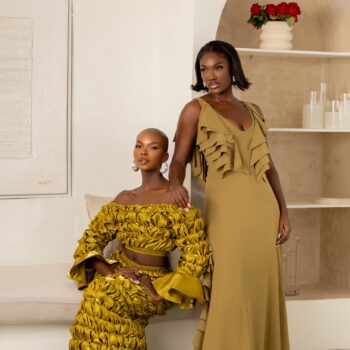In June, I embarked on an intriguing adventure of gathering body measurements for an entire week; and let me tell you, it was an absolute delight. Now, I know what you’re thinking – how can measuring bodies be enjoyable? Well, the why and how is what I’m here to share. In this article, I’ll delve into the fascinating details of how women’s perceptions of their bodies impact their satisfaction with online purchases and why bridging the gap is crucial for the future of African fashion commerce.
 After brainstorming with the team at Seddi, a leading fashion technology company, I engaged in impromptu field research for their latest innovation, Fitroom. Fitroom is a virtual try-on software reshaping the customer fashion shopping experience through its realistic visualization of garments on virtual avatars. Shoppers scan and upload their avatars, get size recommendations, and visualize how the garments would look on their bodies. To achieve global representation in their foundational dataset, I was tasked with creating avatars representing African female bodies, in varying shapes, sizes, and ages, by scanning multiple bodies using an iPhone app.
After brainstorming with the team at Seddi, a leading fashion technology company, I engaged in impromptu field research for their latest innovation, Fitroom. Fitroom is a virtual try-on software reshaping the customer fashion shopping experience through its realistic visualization of garments on virtual avatars. Shoppers scan and upload their avatars, get size recommendations, and visualize how the garments would look on their bodies. To achieve global representation in their foundational dataset, I was tasked with creating avatars representing African female bodies, in varying shapes, sizes, and ages, by scanning multiple bodies using an iPhone app.
I had the opportunity to conduct some scans in person, and it was fascinating to witness the reactions of many women as they caught the first glimpse of their body silhouettes on the screen. Unlike looking in a mirror, when these women viewed their avatars, it was like stepping out of their skins for the first time to see what others saw when they looked at them. The novel experience triggered a range of reactions, from insightful comments to downright hilarious self-assessments, painting a vivid picture of the emotions stirred by body perception. I heard remarks like, “Oh my goodness! I don’t have a waist!” and “Is that fat on my tummy? It’s too much!” One lady even insisted that the scan was inaccurate, claiming her breasts were much bigger. I chuckled!
From my conversations, I noted two recurring themes: dissatisfaction and misconception. Many women are dissatisfied with their bodies but have resigned themselves to their perceived fate. Others hold misconceptions about what their bodies look like, lost in the space between perception and reality.
On the sum of these two themes, I realised many women make clothing choices from a place of dissatisfaction or misconception. Some opt for garments to conceal perceived imperfections, becoming increasingly critical of themselves in the process. Others buy clothes based on their inaccurate perception of their bodies, only to be sorely disappointed when the reality falls short of their expectations. I had observed these patterns before while running my fashion brand, Inighi. Women who were size 14 would insist on ordering a size 10 because “it was stretchy,” and women who could flaunt their figures in curvy silhouettes would opt for baggier designs to hide minor imperfections. It was a phenomenon I couldn’t comprehend back then, but now it makes sense.
My Seddi body scanning experience has resulted in my current hypothesis: many women base their fashion choices on unrealistic or inaccurate perceptions of their bodies, which significantly dampens their shopping experience. With the rise of online commerce, more women are turning to online platforms to make fashion purchases. However, the disconnect between perception and reality can lead to a significant decrease in customer satisfaction and ultimately affect purchase decisions in the fashion industry.
Imagine a woman scrolling through Instagram, looking for the perfect outfit. She selects a dress based on her illusory perception of her body. Her excitement builds as she eagerly awaits the arrival of her purchase, envisioning herself looking flawless in the chosen outfit. However, when the package arrives, she tries on the dress, but her high hopes are shattered. She is disappointed because the garment doesn’t fit as she had imagined. The experience leaves her dissatisfied with the particular purchase and can erode her trust in online shopping.
Imagine another woman who believes her arms and thighs are too thick. To hide these perceived flaws, she consistently chooses oversized tops and dresses in dark colours. As a result, she often feels stifled and restricted in her fashion choices, unable to fully embrace her style and showcase her creativity. The cycle perpetuates a negative self-image and dissatisfaction, which ripples into her shopping experience.
The disconnect between perception and reality is particularly ominous for the African fashion industry, where growth is critical to the future of the continental value chain. When we consider the accessibility to bespoke garments relative to the West, dissatisfaction with online shopping outcomes may prove disruptive to the growth of ready-to-wear fashion. Because many women purchase clothes based on their perception of their bodies, they may experience disappointment when the garments do not fit or flatter them as expected, resulting in negative reviews, returns, and a loss of trust in online ready-to-wear fashion shopping.
**
So, how can we bridge the gap between perception and reality, enabling women to have a more positive and fulfilling shopping experience?
We can leverage virtual try-on software, like Seddi, so women can see how garments look and fit on their unique bodies. When women can create virtual avatars, the door to virtual try-ons opens early in the user journey, shortening the distance between expectation and reality. Such technology has the potential to revolutionize the way women shop online, fostering body positivity and enabling them to make informed purchasing decisions.
We should also champion the promotion of realistic and inclusive representations of women’s bodies in the media and fashion industry to reshape societal standards and redefine beauty ideals. By celebrating diverse body types and challenging the notion of a “perfect” body, we give women the courage to embrace their unique bodies and express themselves through fashion, as it should be.
How women perceive their bodies affects their satisfaction with online purchases and, consequently, the growth of African fashion commerce. By acknowledging and addressing this issue, fashion companies and technology providers like Seddi can contribute to a more inclusive and empowering shopping experience. By embracing diversity, challenging unrealistic standards, and leveraging innovative technologies, we can pave the way for a future where every woman feels confident, celebrated, and satisfied in her skin.




